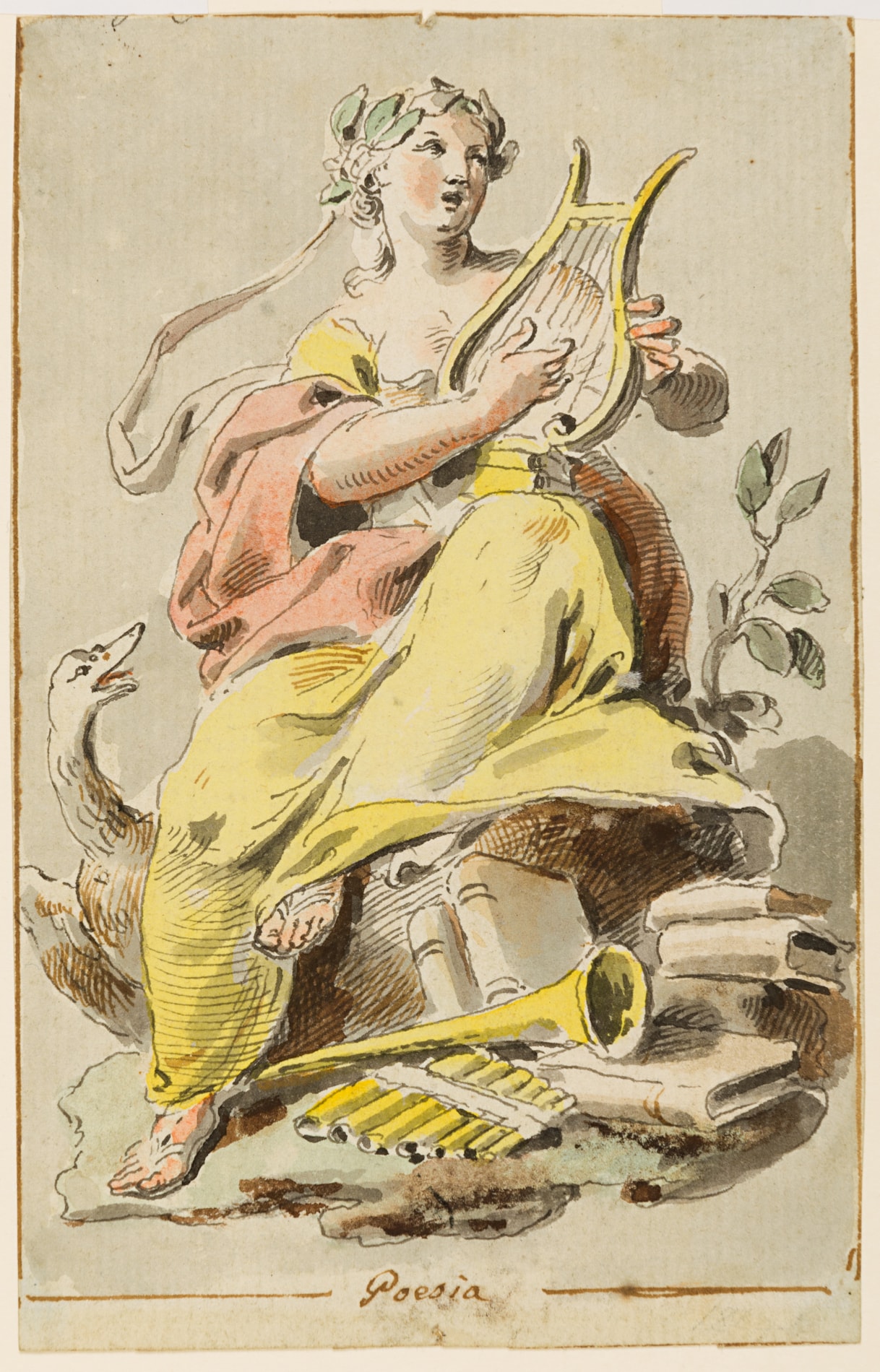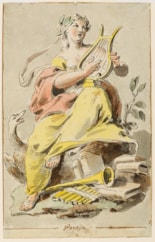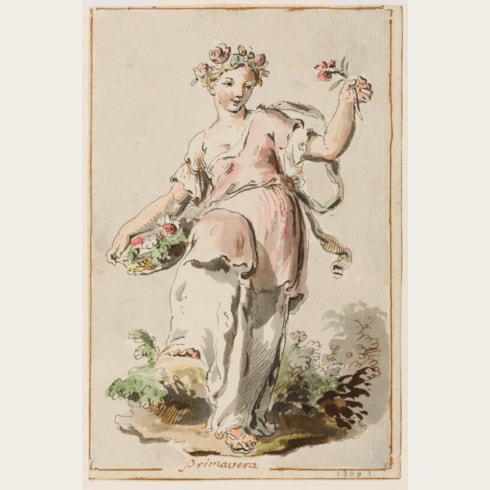Pietro DE ANGELIS
(Rome c.1769 - Rome(?) c.1825)
An Allegorical Figure of Poetry
Watercolour, pen and grey and brown ink and grey wash, with framing lines in brown ink.
Inscribed Poesia at the bottom centre.
143 x 90 mm. (5 5/8 x 3 1/2 in.) [sheet]
Inscribed Poesia at the bottom centre.
143 x 90 mm. (5 5/8 x 3 1/2 in.) [sheet]
The attribution of this drawing to the obscure artist Pietro de Angelis is based on a stylistic comparison with a handful of signed drawings of mythological and allegorical subjects by the artist, for the most part executed in pen and ink and watercolour. His draughtsmanship is typically Venetian in manner, and many of his drawings display the particular influence of the work of the Venetian painter Pietro Antonio Novelli (1729-1804), whose own drawings come very close to those of the younger artist in style, technique and effect. The two artists may well have met; either in Rome, where Novelli worked between 1779 and 1782, or in Venice, which de Angelis is known to have visited in the early 1790s. (A large drawing of a regatta on the Grand Canal, dated 1791 and signed ‘Petrus de Angelis Romanus Fecit’, appeared at auction in London in 1992, with an incorrect attribution to Novelli.)
Among stylistically comparable drawings by Pietro de Angelis is a Design for a Ceiling Decoration with Ceres in her Chariot, signed ‘De Angelis Fecit’, which appeared at auction in New York in 1998, and a study of Venus and Paris, signed ‘Cav. Pietro de Angelis Romano F.’, sold at auction in Italy in 1974. An analogous drawing by the artist, albeit unsigned, depicting a musician crowned with a laurel wreath by a muse, is in the Kunsthalle in Bremen, while also similar in style and technique is an allegorical depiction of the River Arno, which was on the art market in Florence in 2013.
Among stylistically comparable drawings by Pietro de Angelis is a Design for a Ceiling Decoration with Ceres in her Chariot, signed ‘De Angelis Fecit’, which appeared at auction in New York in 1998, and a study of Venus and Paris, signed ‘Cav. Pietro de Angelis Romano F.’, sold at auction in Italy in 1974. An analogous drawing by the artist, albeit unsigned, depicting a musician crowned with a laurel wreath by a muse, is in the Kunsthalle in Bremen, while also similar in style and technique is an allegorical depiction of the River Arno, which was on the art market in Florence in 2013.
Relatively little is known of the life and career of the Italian painter, poet and draughtsman Pietro de Angelis. Of Roman birth and of apparently privileged origins, he was trained in the studio of the German painter Anton Raphael Mengs in Rome. His earliest recorded commission was for mural decorations, depicting the labours of the months of the year, for a café on the Piazza Navona, executed in 1784 and now lost. In 1790 he was tasked with the painting of a ceiling fresco in the Palazzo Badoer in Venice, which remains his only painted work to have survived to this day. The artist appears to have been knighted as a cavaliere di merito sometime in the 1790s, and from then on often signed his drawings with the title of ‘Cavalier’ or ‘Eques’, usually followed by ‘Romano’ or ‘Romans’. In 1793 he is recorded - already described as a cavaliere – as a member of the Accademia degli Unanimi, a literary society in Turin, and was also a member of other learned societies, including the Accademia degli Arcadi in Rome, which was made up of writers.
Soon after the turn of the century, de Angelis appears to have left Italy to live and work north of the Alps. He seems to have spent some time in Russia, to judge from a signed and dated drawing, inscribed ‘De angelis fecit in San Pietrosburgo 1801’, in the Statens Museum for Kunst in Copenhagen, and is recorded as a teacher of perspectival drawing at the University of Vilnius in Lithuania in 1804. By 1810 de Angelis was in Munich, where he lived and worked, as a professor of the Italian language, until at least 1822.
Obviously a cultured and intellectual figure, de Angelis was described by contemporary sources as both an artist and a poet. A book of his poems was published in Frankfurt in 1798 with the title Saggio di poesie, e improvvisi di Pietro de Angelis romano, and other collections of his writings appeared in later years; Saggio di prose e poesie was published in Kosice in 1808 and La calunia scoperta dalla virtu in Vienna two years later.
Soon after the turn of the century, de Angelis appears to have left Italy to live and work north of the Alps. He seems to have spent some time in Russia, to judge from a signed and dated drawing, inscribed ‘De angelis fecit in San Pietrosburgo 1801’, in the Statens Museum for Kunst in Copenhagen, and is recorded as a teacher of perspectival drawing at the University of Vilnius in Lithuania in 1804. By 1810 de Angelis was in Munich, where he lived and worked, as a professor of the Italian language, until at least 1822.
Obviously a cultured and intellectual figure, de Angelis was described by contemporary sources as both an artist and a poet. A book of his poems was published in Frankfurt in 1798 with the title Saggio di poesie, e improvvisi di Pietro de Angelis romano, and other collections of his writings appeared in later years; Saggio di prose e poesie was published in Kosice in 1808 and La calunia scoperta dalla virtu in Vienna two years later.
Provenance
Anonymous sale, Paris, Hôtel Drouot [Piasa], 20 November 2000, part of lot 53
Jean-Luc Baroni Ltd., London.
Jean-Luc Baroni Ltd., London.







